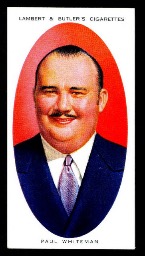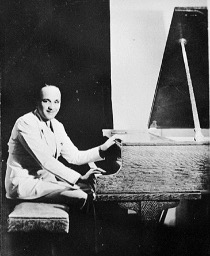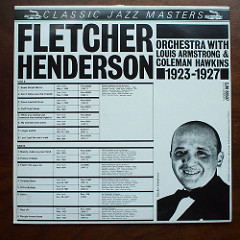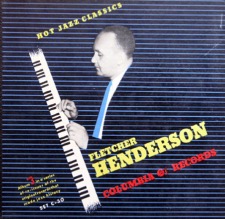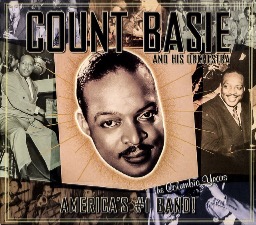Ep00. The history of jazz
Contents
- 1 Discussion
- 2 Jazz History
- 2.1 Introduction to the History of Jazz
- 2.2 History of the Phonograph
- 2.3 Eight Major Revolutions in Jazz
- 2.4 Jazz Styles and Some of Their Representatives
- 2.5 Table of Predominant Jazz Styles by Date
- 2.5.1 Table of Early Jazz Musicians by Instrument and Lifespan Dates
- 2.5.2 Jazz in the 1920’s: Ragtime & Blues
- 2.5.3 Original Dixieland Jazz Band, Joe “King” Oliver (cornet), Louis Armstrong (trumpet), Jelly Roll Morton (piano), Bix Beiderbecke (trumpet), Sidney Bechet (clarinet)
- 2.5.4 Jazz in the 1930’s: Big Band & Swing: Big band orchestras of: Benny Goodman, Duke Ellington, Count Basie
- 2.6 Table of Musical Instrument Abbreviations Meaning
- 2.7 NOTES
Discussion



(Freddie Moore portraits by William P. Gottlieb taken at Gottlieb's Office Party, Jamaica, Queens, New York City, circa 1948.)
(From the William P. Gottlieb Collection at the Library of Congress: http://www.loc.gov/collections/jazz-photography-of-william-p-gottlieb/)
Jazz History
Introduction to the History of Jazz
Jazz has evolved from several different types and strains of music and has itself produced numerous jazz styles. It has always been a hybrid music (combination of types). Pre-cursor music to jazz was European twelve tone classical music, African rhythms, ragtime, marches, brass bands, chamber orchestras, work songs, spirituals, church call and response, dixieland, and even opera. Jazz’s origins can be traced to specific geographical locations starting with New Orleans (Jelly Roll Morton, King Oliver, Louis Armstrong, Sidney Bechet), Chicago (where Oliver and Armstrong went from New Orleans), New York City, Kansas City, Chicago, St. Louis, Philadelphia, Detroit, and Los Angeles.
The origins of jazz are obscure due to the lack of recording technology. The first recorded jazz music is credited to the Original Dixieland Jazz (or Jass) Band in 1917. The music was developed primarily by people of color (non-white) especially Creoles (often in New Orleans people with French heritage) or by West Indies, the islands, or black Afro-Americans. The music was nurtured by urban musicians in New Orleans and played in whorehouses, funeral services, parades, and dance halls.
Although there is controversy over the definition of jazz (see Ontdef3. What is the definition of jazz?, Ontdef2. Arguments for the impossibility of defining jazz, and Ontdef4. Unhelpful definitions of jazz) everyone is agreed that its most important element and part of the essence of jazz playing is improvisation. Improvised music consists of spontaneous composition. The jazz artist must produce new music on the spot often against an established melody or group of chord changes, modes, or musical forms (melody, harmony, rhythm). See PoJ.fm's Ontology: Improvisation section especially Ontimpr1. What is improvisation?.
History of the Phonograph
Thomas Alva Edison (1837–1931) invented the phonograph (literally meaning “sound writer”) in 1877 using tinfoil discs. Edison was not the first to invent a mechanical device that could record sound. The very first recording device was developed by a Frenchman Edouard-Leon Scott de Martinville and patented on March 25, 1857. His device could record sound to a visible medium, but had no means to play back the sound after it was recorded. Edison’s device could do so. However, Edison’s use of tinfoil for his recording and playback medium was impractical as the tinfoil tore easily, its sound was distorted and squeaky, and it was good for only a few playbacks.
A distinct improvement in sound quality and longevity was accomplished by Alexander Graham Bell at Bell’s Volta laboratory in Washington, D.C. using waxed cylinders. Bell and his two associates developed the wax cylinders beginning in 1879 and patented the technique in 1886.
Eight Major Revolutions in Jazz
- (1) Early jazz (1890-1931): Combining Ragtime with the Blues (Jelly Roll Morton 1890-1941)
- (2) Swing (1935-1948) (Duke Ellington, Benny Goodman, Glenn Miller, Count Basie)
- (3) Bebop (1941-1958) (Charlie Parker & Dizzy Gillespie, Thelonious Monk, Max Roach)
- (4) Latin Jazz (1950-future) (Machito, Tito Puente, Cal Tjader, Poncho Sanchez)
- (5) Free jazz (1959-future) (Ornette Coleman, Peter Brötzmann)
- (6) Soul Jazz & Funk Jazz (1965-future) (Horace Silver, Cannonball Adderly)
- (7) Jazz-Rock Fusion (1968-future) (later Miles Davis, Mahavishnu Orchestra, Weather Report, Return to Forever)
- (8) World fusion jazz (1970’s-future) (Don Cherry, Stan Getz, Rudresh Mahanthappa, Anouar Brahem)
Swing era musicians ordered by lifespan with links to biographies at Wikipedia
- Paul Whiteman (1890–1967)
- Fletcher Henderson (1897–1952)
- Edward Kennedy "Duke" Ellington (1899–1974)
- Earl Hines (1903–1983)
- Fats Waller (1904–1943)
- Glenn Miller (1904–1944)
- Jimmy Dorsey (1904–1957)
- Coleman Hawkins (1904–1969)
- William "Count" Basie (1904–1984)
- Tommy Dorsey (1905–1956)
- Johnny Hodges (1907–1970)
- Cab Calloway (1907–1994)
- Benny Carter (1907–2003)
- Art Tatum (1909–1956)
- Ben Webster (1909–1973)
- Benny Goodman (1909–1986)
- Artie Shaw (1910–2004)
- Jay McShann (1916–2006)
- Charlie Christian (1918–1942)
Table of Jazz Musicians by decade and instrument
Tables organizing musicians by dates are problematic. By what criteria should a musician's name be associated with a date? Should it be when he or she is born? No, they have not yet developed musical skills or accomplishments. Even after picking a criterion, it remains a challenge precisely where to put a particular musician into which time period.
The following table uses the criterion of placing musicians into time periods when they first came to prominence. Most of these musicians then remained active in the field for several more decades although their names are not repeated later in the table.
| Time | Style | Horn Player | Pianist | Composer/Arranger | Rhythm Section |
|---|---|---|---|---|---|
| 1920's | Early jazz | Buddy Bolden (cor) Joe "King" Oliver (cor) Nick LaRocca (cor, tr) Sidney Bechet (cl) Louis Armstrong (tr) Bix Beiderbecke (cor) Jack Teagarden (trb) Kid Ory (trb) Red Nichols (cor) |
James P. Johnson Jelly Roll Morton Tony Jackson Earl Hines |
Jelly Roll Morton | Baby Dodds (d) Zutty Singleton (d) Pops Foster (b) |
| Early 1930's | Dance band | Roy Eldridge (tr) Coleman Hawkins (ts) Johnny Hodges (as,ss) Benny Carter (as/cl/tr) Ben Webster (ts) |
Earl Hines Fats Waller Art Tatum Teddy Wilson |
Duke Ellington Fletcher Henderson Cab Calloway Benny Carter Tommy Dorsey Glenn Miller Benny Goodman Artie Shaw Count Basie |
Chick Webb (d) Dave Tough (d) Sid Catlett (d) Gene Krupa (d) Milt Hinton (b) |
| 1935's | Swing | Lester Young (ts/cl) Cootie Williams (tr) Johnny Hodges (ts) Paul Gonsalves (ts) Coleman Hawkins (ts) Ben Webster (ts) Roy Eldridge (tr) Harry “Sweets” Edison (tr) Cootie Williams (ts) Charlie Shavers (ts) |
Duke Ellington Nat King Cole Count Basie Teddy Wilson Erroll Garner Oscar Peterson |
Jay McShann Duke Ellington |
Count Basie Band ‘37-’43 Jimmy Blanton (b) Charlie Christian Herb Ellis (g) Barney Kessell (g) Django Reinhardt (g) Lionel Hampton (vibes) Jimmy Blanton (b) Walter Page (b) Slam Stewart (b) Jo Jones (d) Sam Woodyard (d) ———————— Billie Holiday (voc) Dinah Washington (voc) Ella Fitzgerald (voc) |
| Early 1940's | Bebop | Charlie Parker (as) Dizzy Gillespie (tr) Lester Young (ts,cl) Coleman Hawkins (ts) Roy Eldridge (tr) Sonny Stitt (as,ts) Lucky Thompson (ts,ss) Fats Navarro (tr) Kenny Dorham (tr) Miles Davis |
Thelonious Monk Bud Powell Duke Jordan Al Haig |
Thelonious Monk Charlie Parker Dizzy Gillespie Tadd Dameron |
Charlie Christian (electric guitar) Max Roach (d) Milt Hinton (b) Roy Haynes (d) Kenny Clarke (d) Oscar Pettiford (b) Tommy Potter (b) Charles Mingus (b) Art Blakey (d) Jo Jones (d) Milt Jackson (vibes) |
| Late 1940's | Bebop | Dexter Gordon (ts) Kai Winding (trb) Allen Eager (as, ts) J.J. Johnson (trb) Cecil Payne (b) Sonny Stitt (as) Kenny Dorham (tr) Fats Navarro (tr) Sonny Rollins (ts) James Moody (ts) Clifford Brown (tr) |
Stan Kenton Benny Goodman Woody Herman Claude Thornhill |
Philly Jo Jones (d) Ray Brown (b) | |
| Early 1950's | Cool jazz | Miles Davis (tr) Gerry Mulligan (bs) Lee Konitz (as) Warne Marsh (ts) |
Lennie Tristano | Gil Evans John Lewis Gerry Mulligan |
drummers |
| Late 1950's | West Coast | Art Pepper (as) Chet Baker (tr) Stan Getz (ts) Gerry Mulligan (bs) |
Dave Brubeck | Gerry Mulligan Shorty Rogers Jimmy Giuffre |
Chico Hamilton (d) |
Jazz Styles and Some of Their Representatives
Early Jazz
- Dixieland – (Original Dixieland Jazz Band)
- Ragtime – (Scott Joplin (p))
Big Band Jazz (1920's-1940's)
Michael Verity explains below in green font how jazz began to switch from group and big band arrangements in the late 1930s–early 1940s to increased emphasis on individual solo improvisations. The innovations of Coleman Hawkins (1904–1969) and Lester Young (1909–1959) helped lead to further developments later in Bebop.




“In 1922, Coleman Hawkins moved to New York, where he joined Fletcher Henderson’s (pictured below) orchestra. Inspired by Louis Armstrong who briefly toured with the group, Hawkins resolved to create an individualistic improvisation style.
The primacy of the soloist was budding thanks to Armstrong’s Hot Five recordings on Okeh Records. Famous songs included “Struttin’ With Some Barbecue,” and “Big Butter and Egg Man.” Saxophonist Sidney Bechet’s virtuosity was documented as well, with his 1923 recording of “Wild Cat Blues” and “Kansas City Blues.”In 1927, cornetist Bix Beiderbecke recorded “In a Mist” with C-melody saxophone player Frankie Trumbauer. Their refined and introspective approach contrasted with the gregarious New Orleans style. Tenor saxophonist Lester Young brought the style to prominence, and offered an alternative to the gruffer playing of Coleman Hawkins.
It wasn’t just in tone that the two differed. Young’s specialty was embellishing and creating melodies, while Hawkins became an expert at outlining chord changes by playing arpeggios. The convergence of these two approaches were integral in the development of bebop in later years.”[1] (bold not in original)
- "Sweet" Big Band Dance Orchestras - "sweet" meant more lyrical, slow, and popular (as represented by Paul Whiteman’s band)
- "Hot" Big Band Dance Orchestras - "hot" meant faster, energetic, more powerful – (as represented by Glenn Miller or Fletcher Henderson’s Orchestras)
Swing Bands (1935-1945)
- Swing — Swing music became popular around 1935 (although it began in the late 1920s). It is distinguished by a more supple feel than the more literal 4/4 timing of earlier jazz with a walking bass line developed by Walter Page (1900–1957) — (Duke Ellington’s or Count Basie's Orchestras)
Duke Ellington
Count Basie
Table of Bebop Musicians by Instrument (early 1940's-1955)
- Bebop developed in the 1940's and is characterized by sophisticated improvisations involving fast tempos with rhythmic unpredictability and harmonic complexity. Wikipedia: Bebop explains that Bebop musicians “explored advanced harmonies, complex syncopation, altered chords, extended chords, chord substitutions, asymmetrical phrasing, and intricate melodies.” The term “bebop” is an onomatopoeic reference to the accented melodic lines and references the rhythmic punches heard in the music. A typical Bebop band consisted usually of saxophone and trumpet with rhythm sections of piano, bass, and drums. Because the band had fewer members bebop shifted musical focus from complex band arrangements to increased improvisation and interaction between members. The Bebop rhythm section (piano, bass, drums) innovated as well in that their roles were expanded from just being time-keepers to interacting with soloists and adding their own embellishments. Bebop drummers Kenny Clarke and Max Roach often get credited for shifting focus from the bass drum to the ride cymbal as the main time-keeping element of the drum set. This permitted greater flexibility in a group's overall sound and allowed soloist's room to experiment with rhythm while enabling drummers to interact more easily with soloists.
| Trumpet 🎺 | Saxophone 🎷 | Piano 🎹 | Bass 🎻 | Drum 🥁 | Guitar 🎸 | Miscellaneous 🎼 |
|---|---|---|---|---|---|---|
| John Birks "Dizzy" Gillespie | Charlie "Bird" Parker (as) | Thelonious Monk | Oscar Pettiford (dbl. b, cello) | Max Roach | Charlie Christian | J.J. Johnson (trb) |
| Fats Navarro | Sonny Stitt (ts,as) | Bud Powell | Ray Brown | Kenny Clarke | Kenny Burrell | Milt "Bags"Jackson (vibes) |
| Clifford Brown | Dexter Gordon (ts) | Hank Jones | Edward Robinson | Denzil Best | Herb Ellis | Buddy DeFranco (cl) |
| Joe Guy | Sonny Rollins (ts) | Clyde Hart | Milt Hinton | Roy Haynes | Barney Kessel | Carl Fontana (trb) |
| Kenny Dorham | James Moody (ts) | Erroll Garner | Gene Ramey | Art Blakey | Pat Martino | Curtis Fuller (trb) |
| Miles Davis | Don Byas (ts) | Al Haig | Tommy Potter | Eddie Nicholson | Wes Montgomery | Frank Rosolino (trb) |
| Chet Baker | Gene Ammons (ts) | Dodo Marmarosa | Slam Stewart | Jimmy Cobb | Joe Pass | |
| Howard McGhee | Leo Parker (baritone) | Sadik Hakim | Curley Russell | Stan Levey | Jimmy Raney, | |
| Blue Mitchell | Lucky Thompson (ts) | John Lewis | Paul Chambers | Philly Joe Jones | Ronnie Singer | |
| Lee Morgan | Wardell Gray (ts) | Tad Dameron | Percy Heath | Eric Ineke | Carlton Kitto | |
| Red Rodney | Julian "Cannonball" Adderley (as) | Lennie Tristano | Charles Mingus (p) | |||
| Ed Zandy | Lee Konitz (as) | Walter Davis, Jr. | ||||
| Charles McPherson (as) | Barry Harris | |||||
| Frank Morgan (as) | Ahmad Jamal | |||||
| Art Pepper (as) | Duke Jordan | |||||
| Pepper Adams (baritone) | Lou Levy | |||||
| John Coltrane (ts,ss) | Oscar Peterson | |||||
| Charlie Rouse (ts) | Horace Silver | |||||
| George Wallington | ||||||
| Bill Evans |
SWING ERA including trumpeters Joe Guy, Hot Lips Page, Roy Eldridge
- Cool jazz/West Coast jazz – (Miles Davis (tr), Chet Baker (tr), Gerry Mulligan (bs), Dave Brubeck (p), Lennie Tristano (p))
- Bossa Nova - Brazilian music and jazz (Stan Getz (ts))
- Modal Jazz - (Miles Davis’s “Kind of Blue”)
- Hard Bop - (Art Blakey’s Jazz Messengers, Horace Silver (p), Clifford Brown (tr), Lou Donaldson (as), Max Roach (d), Miles Davis (tr) in the early 1950's, Jimmy Smith (org), Stanley Turrentine (ts), Julian "Cannonball" Adderley (as), Johnny Griffin (ts), Eddie "Lockjaw" Davis (ts), Kenny Clarke/Francy Boland Big Band, Charlie Rouse (ts,fl))
- Free jazz - (Ornette Coleman (ts,as,vio,tr), Peter Brötzmann (as), Albert Ayler (ts,as))
- Soul Jazz - (Cannonball Adderley (as), Horace Silver (p))
- Latin Jazz - (Machito (voc, conductor, maraca's), Tito Puente (timbales), Cal Tjader (vibes), Poncho Sanchez (congas))
- Third Stream - classical music & jazz (Paul Whiteman (viola, violin, conductor), Gunther Schuller (theorist, conductor, French horn, fl), Modern Jazz Quartet)
- Jazz-Rock fusion – (post 1969 Miles Davis, Mahavishnu Orchestra, Weather Report, Return to Forever)
- Table of Post Bop jazz musicians by instrument
| Trumpet | Saxophone | Trombone | Piano | Bass | Drums | Guitar | Miscellaneous |
|---|---|---|---|---|---|---|---|
| Miles Davis (1956-68) | John Coltrane (ts,as) | J. J. Johnson | Tommy Flanagan | Paul Chambers | “Philly” Joe Jones | Kenny Burrell | Jimmy Guiffre (cl) |
| Freddie Hubbard | Eric Dolphy (as) | Curtis Fuller | Herbie Hancock | Ron Carter | Jimmy Cobb | Joe Pass | Eric Dolphy (fl,cl,bcl,piccolo) |
| Lee Morgan | Julian “Cannonball” Adderley (as) | McCoy Tyner | Jimmy Garrison | Tony Williams | Wes Montgomery | ||
| Woody Shaw | Wayne Shorter (as,ss) | Red Garland | Charles Mingus (p) | Elvin Jones | Jim Hall | Larry Young (org) | |
| Booker Little | George Coleman (as,ts) | Bill Evans | Scott LaFaro | Paul Motion | Toots Thielemans (harmonica) | ||
| Nat Adderley | Sonny Rollins (ts) | Wynton Kelly | Ray Brown | Billy Higgins | Bobby Hutcherson (vibes) | ||
| Donald Ayler | Jackie McLean (as) | Hank Jones | Percy Heath | Ben Riley | |||
| Donald Byrd | Dexter Gordon (ts) | Bobby Timmons | Sam Jones | Ed Blackwell | |||
| Benny Carter | Joe Henderson (ts) | Mal Waldron | Buster Williams | ||||
| Ted Curson | Charlie Rouse (ts,fl) | Andrew Hill | Reggie Workman | ||||
| Joe Lovano (ts) | Cedar Walton | Doug Watkins | |||||
| Phil Woods (as) | Chick Corea | Red Mitchell | |||||
| Ahmad Jamal | |||||||
| Gil Evans (orch) |
- Table of Post Bop Jazz Vocalists
| Female | Male |
|---|---|
| Sarah Vaughan | Jon Hendricks |
| Betty Carter | Eddie Jefferson |
| Carmen McRae | |
| Abbey Lincoln | |
| Shirley Horn | |
- World fusion jazz – (Shakti, Nguyen Le)
- Heavy Metal Jazz – (Last Exit)
- Creative Improvised Music – heavy blowing, traditional/non-traditional, and free (Sun Ra, Peter Brötzmann, Anthony Braxton, AACM, Henry Threadgill)
- color
Table of Predominant Jazz Styles by Date
Table of Early Jazz Musicians by Instrument and Lifespan Dates
- Ragtime, Dixieland, Piano Professors
- Migration from New Orleans to other large cities (Chicago, New York, Los Angeles, Kansas City, Memphis, etc.)
| Musician | Instrument | Lifespan Dates |
|---|---|---|
| Buddy Bolden |
Cornet |
1877–1930
|
| Joe "King" Oliver |
Cornet |
1885–1938
|
| Kid Ory |
Trombone |
1886–1973
|
| Freddie Keppard |
Cornet |
1889–1933
|
| Nick LaRocca |
Cornet, Trumpet |
1889–1961
|
| Jelly Roll Morton |
Piano |
1890–1941
|
| Johnny St. Cyr |
Banjo |
1890–1966
|
| Johnny Dodds |
Clarinet |
1892–1940
|
| Sidney Bechet |
Clarinet |
1897–1959
|
| Willie "The Lion" Smith |
Stride piano |
1897–1973
|
| Lil Hardin Armstrong |
Piano |
1898–1971
|
| Louis "Satchmo" Armstrong |
Cornet, Trumpet |
1901–1971
|
| Bix Beiderbecke |
Cornet |
1903–1931
|
| Earl "Fatha" Hines |
Piano |
1903–1983
|
| Red Nichols |
Cornet |
1905–1965
|
| Art Tatum |
Piano |
1909–1956
|
Jazz in the 1920’s: Ragtime & Blues
Original Dixieland Jazz Band, Joe “King” Oliver (cornet), Louis Armstrong (trumpet), Jelly Roll Morton (piano), Bix Beiderbecke (trumpet), Sidney Bechet (clarinet)
Jazz in the 1930’s: Big Band & Swing: Big band orchestras of: Benny Goodman, Duke Ellington, Count Basie
1931–1957
Count Basie, Benny Goodman, Duke Ellington, Louis Armstrong, Earl Hines, Jimmie Lunceford, Tommy Dorsey, Mills Blue Rhythm Band, Fletcher Henderson, Woody Herman, Artie Shaw, Chick Webb, Don Redman, Charlie Barnet, Casa Loma Orchestra, Lionel Hampton & Claude Hopkins, Georgie Auld, Cab Calloway, Bob Crosby, Jimmie Dorsey, Teddy Hill, Harry James, Gene Krupa, Stan Kenton, Glenn Miller, Shorty Rogers, Pete Rugolo, and Jack Teagarden.
1930–40s: Buddy Tate, Earle Warren, Jo Jones, Dickie Wells and Buck Clayton along with reminiscences from Andy Kirk, John Hammond.
Table of Musical Instrument Abbreviations Meaning
| Abbreviation as |
Musical Instrument alto saxophone |
Yello color
Green color
yellowish background color below
style="background:#ffdead;"
| Abbreviation | Musical Instrument | |
|---|---|---|
| as | alto saxophone | |
| b | bass | |
| bs | baritone saxophone | |
| cello | cello | |
| cl | clarinet | |
| co | cornet | |
| d | drums | |
| eg | electric guitar | |
| p | piano | |
| ss | soprano saxophone | |
| tr | trumpet | |
| trb | trombone | |
| ts | tenor saxophone | |
| vibes | vibraphone | |
| vio | violin | |
| voc | vocalist | |
Jazz in the 1940s: Roy Eldridge (trumpet), Coleman Hawkins (tenor saxophone), Ben Webster (tenor saxophone), Lester Young (tenor saxophone)
Jazz in the 1950s – Bebop: Charlie “Bird” Parker (alto saxophone)
Cool Jazz, West Coast Jazz, Hard-Bop and Modern Mainstream
Cool Jazz: Miles Davis, Dave Brubeck, Modern Jazz Quartet, Lee Konitz, Gerry Mulligan, Shorty Rogers, Tony Scott & Bill Evans, J. J. Johnson, Lennie Tristano.
West Coast: Stan Getz, Chet Baker, Gerry Mulligan, Jimmy Giuffre, Herb Geller, Barney Kessel, Clifford Brown, Tadd Dameron, Serge Chaloff, Shelly Manne, Art Pepper, Shorty Rogers, Howard Rumsey.
Hard Bop: Clifford Brown, John Coltrane, Sonny Rollins, Art Blakey, Cannonball Adderley, Thelonious Monk, Lee Morgan, Horace Silver, Jimmy Smith, Cannonball Adderley, Nat Adderley, Art Blakey, Thelonious Monk, Sony Clark, Paul Chambers, Miles Davis, Kenny Dorham, Dexter Gordon, Johnny Griffin, Thad Jones, Jackie McLean, Charlie Mingus, Hank Mobley, Max Roach, Prestige All-Stars.
Modern Mainstream: Dizzy Gillespie, Mose Allison, Kenny Burrell, Al Cohn, Zoot Sims, Herb Ellis, Erroll Garner, Dizzy Gillespie, Sonny Rollins, Sonny Stitt, Milt Jackson, J. J. Johnson, Kai Winding, Quincy Jones, Oscar Peterson, Buddy DeFranco, Oscar Peterson, Zoot Sims, Birdland Stars, Four Brothers.
NOTES
- ↑ "Jazz by Decade 1930-40" by Michael Verity at ThoughtCo.com








